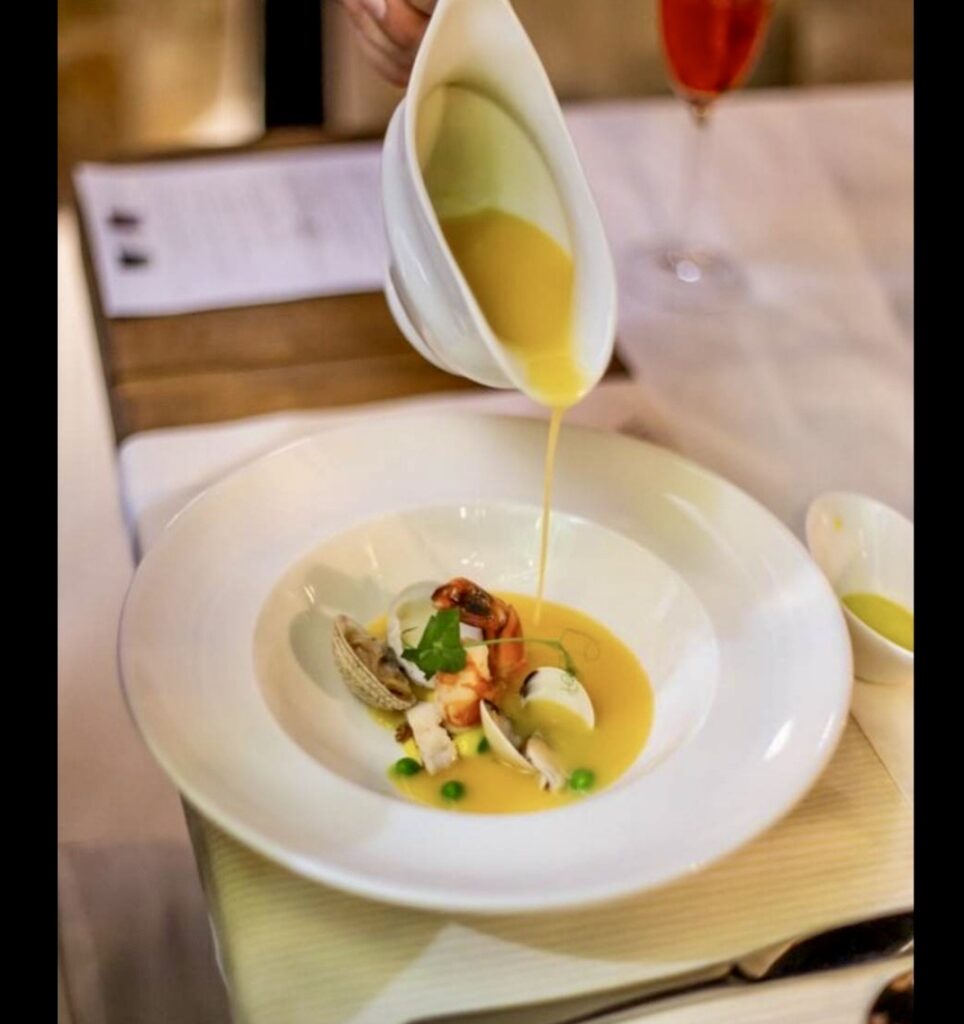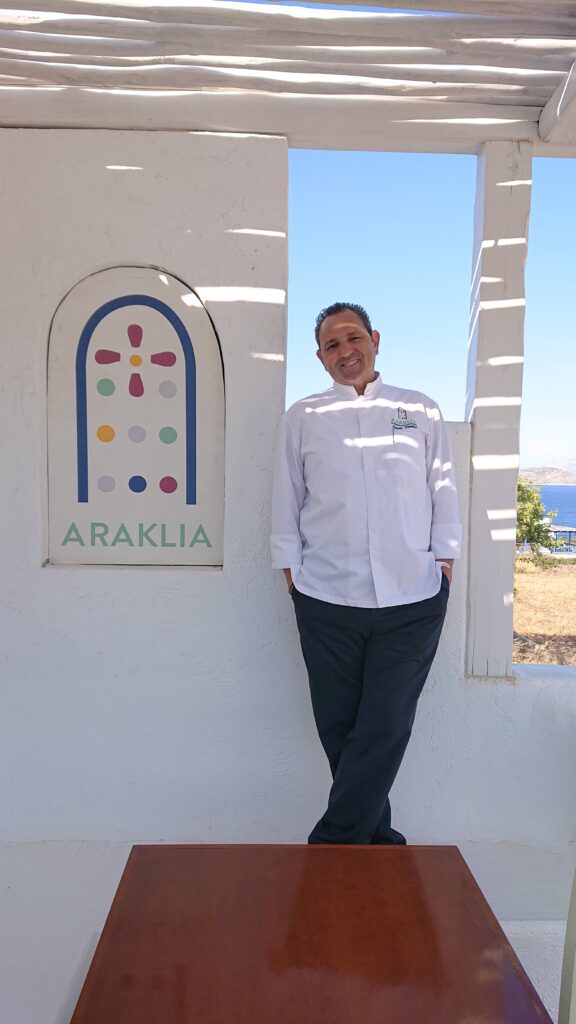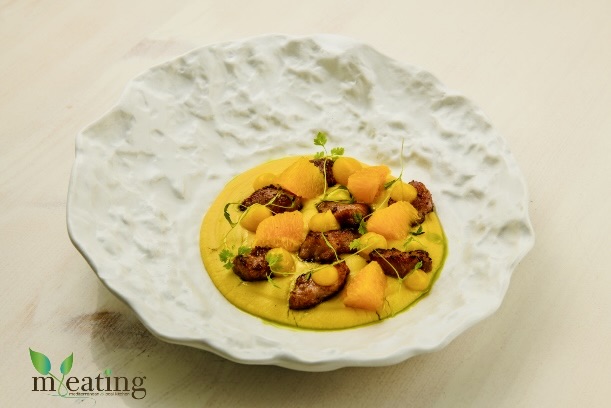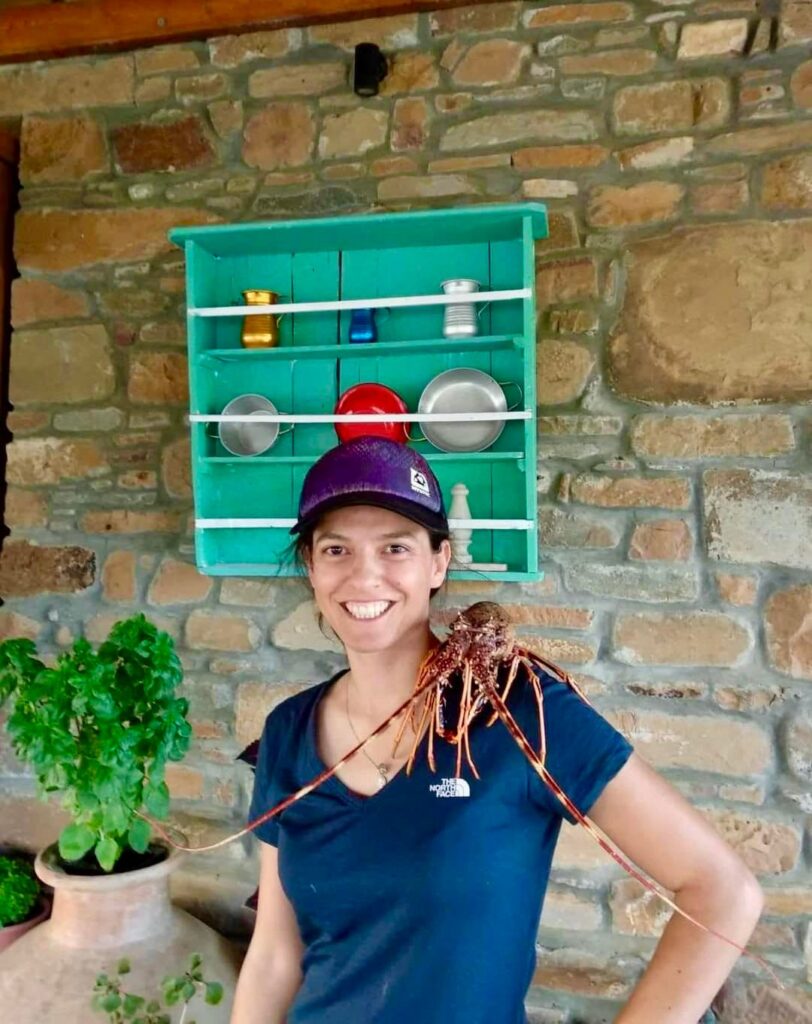Greek islands Chefs differentiate for the purity of character, tradition, raw materials redirected in their cooking and stirring dishes.

Text curation: Katerina Karsioti & Konstantinos Koveos
360 degrees round the Greek islands, flavor is a voyage and in a parallel manner a great station. Wherefore, amid recipes and raw materials, tradition, culture, customs and above all characters unfurl.
From Crete, Corfu & Mykonos to Lemnos, Mytilini & Heraklia, Greek islands Chefs cook and lay the luncheon table with the most mouthwatering recipes for your own…summer culinary experience.
Tasos Andriotis, Chef at Rose Garden Corfu Gastronomy and Executive Chef at Angsana Corfu Resort & Spa, Yannis Gavalas, Chef of Araklia restaurant in Heraklia, Stratos Iosifellis, Executive Chef of Mythical Coast Hotel in Lesvos & Consultant Chef of Greek Breakfast, Panagiotis Menardos, Chef of M-eating restaurant in Mykonos, Malama Banavou, Chef of Flomari restaurant in Limnos & Vassilis Leonidou, Executive Chef at Avli restaurant in Rethymnon, Crete invite you to their beloved islands and prepare especially for you “dishes” that will constitute the ultimate “experience” of your summer!






Favorite ingredients are introduced to your table by 6 cherished Greek islands Chefs in the most creative way and refer each region through distinctive flavors, aromas and local products.
Τhe way in which you fathom better off a country
is within its gastronomy…
Tasos Andriotis/ Chef at Rose Garden Corfu Gastronomy & Executive Chef at Angsana Corfu Resort & Spa
With cuisine inspired by the richness of Greek nature, the President of the Chef Club of Corfu, Tassos Andriotis, takes our taste buds off with the unpretentious combination of traditional Korfiati flavors in a modern performance.
A substantial kitchen, which showcases them natural flavors to traditional and innovative combinations, intriguing the mind and the palate.

Bianco velouté with sea bass fillet, shrimps and scallops

For Bianco velouté
- Olive oil for sautéing
- 400 gr. potatoes
- 100 gr. carrots
- 80 gr. celery
- 3 cloves of garlic
- Juice of 1 lemon
- 1.5 lt. Fish stock
- Salt & Pepper
Cooking instructions
Peel and chop the carrots, potatoes and garlic.in a wide pot, sauté the carrot, add garlic, potato, cover with broth and simmer until all the vegetables are soft. Season and pour lemon. Tranfer the mixture to a blender and whip well. Pass the sauce with the help of a fine sieve.
For the sea bass and prawns
- 4 sea bass fillets
- 4 prawns cleaned
- 100 ml. extra virgin olive oil
- Salt and pepper
Cooking instructions
Season the fillets and dry them well. In a hot pan with olive oil, saute the skin side well until it becomes crispy and lay it in the oven for 3 minutes. Continue and saute the shrimp for 1 minute.
For the vegetables
- artichokes
- peas
- 1 carrot
Cooking instructions
Peel the carrot. Cut it into sticks and boil it in fish broth until along with the peas. Peel the artichokes, remove the stem and sprinkle with lemon so they don’t blacken. Cut them into slices and lightly saute together with the rest of our vegetables. Sprinkle with a few drops of lemon juice and season with salt and pepper.
For the shells
In a small pot, place the shells with some garlic and herbs to steam and deglaze with white wine.
For the plating
Place the shrimp, shells and vegetables on a plate. Serve on the table velouté sauce Bianco and subsequently fish and shrimp as well.
Yannis Gavalas, Chef at Araklia restaurant in Heraklia
With a view of the Micro Cycladic Polynesia of Schinoussa, Keros, Koufonisi and Amorgos and using his father’s house, Yiannis Gavalas gave life to one lifelong dream by turning it into a fully functional and open space restaurant.Araklia since 2019 granting memories of authentic Aegean cuisine.

Stuffed goat from Heraklia

Ingredients
- Goat (the part in front without the legs)
- 1 liver (excluding spleen)
- 4 pieces of fresh onions (white only)
- 1 dry onion
- 1 bunch of dill
- 1/2 bunch fennel
- Juice of 2 lemons
- 2-3 sprigs of rosemary
- 500 gr. yellow rice for pilaf
- 300 ml olive oil
- Salt
- Pepper
- 2-3 glasses of water
- 2-3 vine branches or sprigs of rosemary
Cooking instructions
Remove both legs from the goat and keep the chest. Wash the goat, dry it and add salt and pepper. Sew the neck and half of the belly so that we can stuff later more comfortably. For the filling, heat olive oil in a pan, add the chopped onions (both fresh and dry) and sauté.
When are glossy, add the chopped liver (washed in water and vinegar) and saute lightly before adding the rice. Mix. Following, add 2 glasses of water, lemon juice and season with salt and pepper. Boil until water evaporates, remove from the heat and subjoin the chopped herbs and let it rest for a short while.
Stuff the goat and close by sewing the remaining piece. Make 1-2 punctures on the side of the meat on the surface and add salt, pepper and a sprig of rosemary.
Place the stuffed goat in a pan where we have placed vines and sprigs of rosemary. Season the meat with salt and pepper, drizzle with a little olive oil and juice from a lemon and add water to the pan.
Bake in a preheated oven at 250 degrees for one hour without stirring. Then, cover it with parchment paper and aluminum foil, lower the temperature to 200 degrees and bake for at least 2 additional hours depending on the size. Uncover and bake for another 10-15 minutes until it forms a thin crust.
Stratos Iosifellis/ Executive Chef of Mythical Coast Hotel in Lesvos & Consultant Chef of Greek Breakfast
With its cultural imprint indelibly etched in the memory of the modern traveler, Lesvos, home of ouzo and fine products composes a canvas of authentic images, tastes and aromas.
Stratos Iosifellis with many years of experience in the culinary promotion of Northeast Aegean invites us to discover the mythical Mytilini.

Lesvos onion dumplings (Sougania with vegetables and rice)

Ingredients
- 10-15 large onions
For the filling
- 60 gr. olive oil
- 300 gr. glutinous rice
- 600 ml. water or vegetable stock
- 10 gr. garlic
- 200 gr. zucchini
- 200 gr. carrot
- 150 gr. dry onion (or the hearts which we will remove from the large onions)
- 150 gr. fresh onion
- 120 gr. leek
- 20 gr. sugar
- 30 gr. parsley
- 30 gr. mint
- 10 gr. anise
- 20 gr. tomato paste
- 300 gr. grated tomatoes
- Salt
- Pepper
Cooking instructions
For the onions
Peel them and score them one by one with a sharp knife, stopping at heart. Blanch them for 5 minutes in boiling water and cool. Then carefully unfold them, removing one by one the layers. Keep the pieces that cannot be filled. Prepare the filling by chopping the onion hearts that we held shortly before and mix them with the rest of the ingredients.
For the filling
In a non-stick pan over high heat, pour a few drops of olive oil. Pour in the chopped filling from the onion hearts that we kept. Chop the garlic, leek, grate the zucchini, carrot and slice the spring onion and add them to the pan. Add the sugar. Mix with a spoon until our vegetables caramelise. Add enough salt and pepper because we will also add the rice. Add the rice and saute for 3-4 minutes until it is dried. Add the tomato paste and cook. Put 200 ml. broth and cook for another 5 minutes.
Turn off the heat and add the grated tomato.
Chop herbs and add them to the mixture. Take spoonfuls of the filling and fill each onion leaf. Then, roll it up and place it in a pan. Arrange all stuffed leaves next to each other tightly in the pan (with the exact same way we prepare stuffed leaves).
Panagiotis Menardos, Chef at M-eating restaurant in Mykonos
In a traditional Mykonian building with an architectural history dating back to a century ago, in the center of Mykonos Town, a breath away from Matogianni, nests the M-eating restaurant with Panagiotis Menardos, Chef and orchestrator of culinary librettos featuring local cuisine.

Myconian cissera on fava beans with fillets and orange jelly

Ingredients for cissera
- 1 kg pork neck
- 150 gr. olive oil
- 150 gr. glina (melted pork fat)
- peppercorns
- Bay leaves
For the split peas
- 300 gr. split peas
- salt and pepper
- Olive oil and lemon as a finishing touch
For the orange jelly
- 500 gr. fresh orange juice
- 5 gr. agar agar
Cooking instructions for cissera
Slice the neck into small pieces and place in a large pot with 1.5 litres of water, olive oil, pork fat, peppercorns and bay leaf. Boil until it absorbs all its liquids and starts to saute including its fat inside the pot. When it gets a brown color, remove from the heat.
Cooking instructions for the split peas
Boil the fava beans with twice as much water compared to the amount of fava beans and a medium onion cut into 8 pieces. When it boils, remove it from the heat and whip with the use of a blender by adding salt, pepper, lemon and olive oil of your preference.
Cooking instructions for the orange jelly
Put the juice to boil after passing it through a sieve and after it boils, add the agar agar, mix well and pass it through a sieve again. Leave it in a bowl to cool down and freeze it in the fridge until it stabilises. Beat it with a blender to get the texture you want and adjust with sugar if necessary.
Arrange the plate with the fava beans below, the meat above and finish with the orange jelly. Decorate with orange fillets.
Malama Banavou/ Chef of Flomari restaurant in Lemnos
On the beautiful volcanic island of the Northeast Aegean and history that is being lost in the depths of the centuries, Malama Banavou unfolds its own culinary narrative in the Flomari restaurant with emphasis on family-produced organic products and seasonality of indigenous raw materials.

Flomaria Lemnos with spinach, walnuts and Mornay sauce with melichloro cheese

Ingredients
- 350 gr. Flomaria of Lemnos with spinach
- 130 gr. walnuts
- 100 gr. butter
- 50 gr. flour
- 500 ml. milk
- 150 gr. grated Melichloro cheese
- 2 egg yolks
- 1 clove of garlic
- salt, pepper, nutmeg
- fried spinach leaves for garnish & cherry tomatoes
Cooking instructions
In a blender mix garlic, walnuts and 50 grams of butter.
In a pot of salted water, boil the spinach-flavored pasta for about 5 minutes. We want these to be served al dente. While the pasta is boiling, prepare the Mornay sauce with melichloro cheese.
Melt the 50 grams of butter in a saucepan, add 50 grams of flour and mix with a whisk until it gets a pleasant color. Then, lower the temperature, pour the milk and mix until the sauce thickens. At the time that the sauce thickens, remove from the heat and add the grated cheese, season with nutmeg, pepper, salt if needed and two egg yolks.
In a strainer, drain the pasta and put them to the pot along with the walnut-butter mixture. Heat for 2 minutes while stirring. Divide the mixture into individual circles or on a baking sheet, add the Mornay sauce and a little extra grated cheese.
Bake in a preheated oven at 185°c until it gets a golden brown color (approximately 20 minutes).
Serve with fried spinach leaves and cherry tomatoes with sea salt.
Vassilis Leonidou/Executive Chef at Avli restaurant- Rethymno, Crete
Crete, a unique island with an abundance of products! I chose a favorite recipe served at Avli Crete restaurant such as “Amariotiko chicken with askordoulakous” from the surrounding area. This is a product that is never absent from Crete and has become more and more popular in recent years!
Bon appetit to all in tandem with taste & Cretan flavors!

Rooster with askordoulakous and corn sauce

Ingredients
- 1 kg rooster in pieces
- 200 gr. onion
- 2 cloves of garlic
- 1 carrot
- 1 small piece of ginger
- 1 glass of red wine
- 1 teaspoon of tomato paste
- 2 medium tomatoes
- extra virgin Olive Oil
- salt and pepper
- laurel
- star anise
- pearl onions
- fresh or pickled askordoulakous
- 1 spoon of honey
For the corn sauce
- fresh corn
- extra virgin Olive Oil
- 1 onion
- 1 clove of garlic
- chicken stock
Cooking instructions
Clean and de-bitter the bulbs. Otherwise, if we use pickle, wash well with water 2 to 3 times. Then, saute the rooster in olive oil and remove from the pot, add the coarsely chopped vegetables and when they turn brown, add the paste and deglaze with wine. Restore the rooster. When wine evaporates, add the tomato, water and spices and simmer until the rooster is tender. 10 minutes before, add plenty of askordoulakous as well as a spoonful of honey.





Ολα πολυ ομορφα και ωραια!
Συγχαρητηρια στους Σεφ, για τις ομορφες και νοστιμες συνταγες τους
οπως και στην επιμελεια κειμενου!
Μια φιλικη παρατηρηση μονο…
Το κολαζ φωτογραφιων των Σεφ, ΔΕΝ αντιστοιχει επακριβως με
το κολαζ φωτογραφιων τοπιου, οπου εργαζονται-δραστηριοποιουνται
τα ανωτερω προσωπα.
Σας ευχαριστούμε για τα θετικά σχόλια και την παρατήρησή σας. Κατά την συγγραφή του άρθρου, στόχος μας ήταν να αναδείξουμε τις προσωπικότητες των Σεφ. Το φωτογραφικό υλικό που το συνόδευσε εστιάστηκε σε αυτούς, τις δημιουργίες και τα νησιά από όπου προέρχονταν. Κρίναμε σκόπιμο να μην εντάξουμε φωτογραφίες των εστιατορίων και ξενοδοχειακών μονάδων όπου δραστηριοποιούνται καθώς οι επωνυμίες αυτών αναγράφονται κατόπιν των ονομάτων τους.